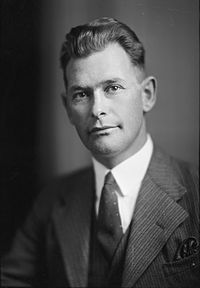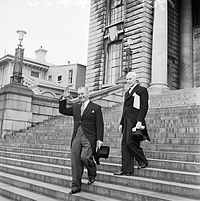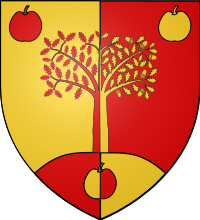- Keith Holyoake
-
The Right Honourable
Sir Keith Holyoake
KG, GCMG, CH, QSO, KStJ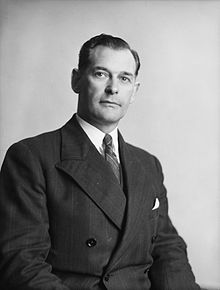
Keith Holyoake in 1960 13th Governor-General of New Zealand In office
26 October 1977 – 25 October 1980Monarch Elizabeth II Preceded by Sir Denis Blundell Succeeded by Sir David Beattie Constituency Motueka, Pahiatua 26th Prime Minister of New Zealand In office
12 December 1960 – 7 February 1972Monarch Elizabeth II Governor General Charles Lyttelton
Bernard Fergusson
Arthur PorrittDeputy Jack Marshall Preceded by Walter Nash Succeeded by Jack Marshall In office
20 September 1957 – 12 December 1957Monarch Elizabeth II Governor General Charles Lyttelton Deputy Jack Marshall Preceded by Sidney Holland Succeeded by Walter Nash 1st Deputy Prime Minister of New Zealand In office
13 December 1949 – 20 September 1957Prime Minister Sidney Holland Preceded by None (new office) Succeeded by Jack Marshall Member of the New Zealand Parliament
for MotuekaIn office
1932–1938Preceded by George Black Succeeded by Jerry Skinner Member of the New Zealand Parliament
for PahiatuaIn office
1943–1977Succeeded by John Falloon Personal details Born 11 February 1904
Pahiatua, New ZealandDied 8 December 1983 (aged 79)
Wellington, New ZealandPolitical party Reform
NationalSpouse(s) Dame Norma Janet Ingram, DCMG QSO (m. 1934) Children 5 Profession Farmer Religion Presbyterian Sir Keith Jacka Holyoake, KG, GCMG, CH, QSO, KStJ (11 February 1904 – 8 December 1983) was a New Zealand politician. The only person to have been both Prime Minister and Governor-General of New Zealand,[1] Holyoake was National Party Prime Minister from 20 September 1957 to 12 December 1957, then again from 12 December 1960 to 7 February 1972. He was appointed as Governor-General in 1977 and served until 1980.
Holyoake is to date the third longest serving New Zealand Prime Minister (just under 12 years), surpassed only by Richard Seddon's 13 years and William Massey's close to 13 years; he was also the first to be born in the 20th century.[2] He was known for his diplomatic style and "plummy" voice. He was also fondly (or mockingly) known as Kiwi Keith, a name given to him in childhood to distinguish him from an Australian child with the same name.[2]
Contents
Early life
Holyoake was born at Mangamutu,[2] a short distance from Pahiatua, a town in New Zealand's Wairarapa region, the son of Henry Victor Holyoake and Esther Eves. The Holyoakes great-grandparents settled in the district in 1843, and were relatives of 19th century radical George Holyoake.[3] The Holyoakes ran a small general store and consequentially moved around the country often. His family lived for a time in both Hastings and Tauranga, but in 1913, settled in Riwaka, near Motueka.[3]
At age 12, having left school after his father's death, Holyoake worked on the family hop and tobacco farm in Riwaka. His mother had trained as a school teacher, and continued his education at home. After taking over the management of the farm, he became involved in various local farming associations, something that increased his interest in politics.
The Reform Party, which had strong rural support, selected Holyoake as its candidate for the Motueka seat in the 1931 election. The incumbent MP, George Black, held the seat, but died the following year. Holyoake was the Reform Party's candidate in the resulting by-election in 1932, and was successful. He became the youngest Member of Parliament at the time, at the age of 28.[2]
In the 1935 election, Holyoake retained his seat under the motto "Follow England and Vote Holyoake"[2] despite a massive swing against the Reform-United coalition. In the aftermath of this election, he played a key role in transforming the coalition into the modern National Party. He very quickly gained considerable respect from his colleagues, and was regarded as a rising star in the new party. But in the 1938 election, Holyoake lost his seat to a rising star of the governing Labour Party, Gerry Skinner.
In 1943 he returned to Parliament as MP for Pahiatua, having been lined up by National for that nomination. In 1946, he became the party's Deputy Leader.
Early political career
Cabinet minister
Parliament of New Zealand Years Term Electorate Party 1932–1935 24th Motueka Reform 1935–1938 25th Motueka Reform 1943–1946 National 1946–1949 National 1949–1951 29th Pahiatua National 1951–1954 National 1954–1957 National 1957–1960 National 1960–1963 National 1963–1966 National 1966–1969 National 1969–1972 National 1972–1975 National 1975–1977 National National won the 1949 election and formed the First National Government, new Prime Minister Sidney Holland appointed Holyoake as Minister of Agriculture. Holyoake was also was for a year (1949–50) in charge of the Department of Scientific and Industrial Research, and was Minister of Marketing until the department was abolished in 1953.[3] As Minister of Agriculture for eight years Holyoake enhanced his reputation as a level-headed good administrator. Farm mechanisation was encouraged, the "extermination policy" achieved nearly eliminated the rabbit pest. Dismantling of marketing producer controls was completed.[3]
Holyoake twice went to London re-negotiate price levels on meat and wool products,[3] and in 1955 attended the Food and Agricultural Organisation conference in Rome. On his return to New Zealand he visited India and the USSR to seek alternative markets for New Zealand, although his trip bore little fruit.[3] In 1957 he led a delegation seeking to protect New Zealand's access to the British market without notable success.[3]
As Deputy leader of the National Party, Holyoake was acting prime minister whenever Holland was overseas. In recognition of this was made a member of the Privy Council in 1954, only after the 1954 general election Holland made him the first person to be formally appointed Deputy Prime Minister.[3]
Prime minister
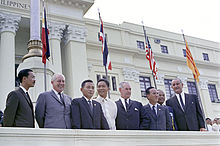 Keith Holyoake (fifth from the left) at a meeting of SEATO allies, outside the Old Congress Building in Manila, Philippines on 24 October 1966.
Keith Holyoake (fifth from the left) at a meeting of SEATO allies, outside the Old Congress Building in Manila, Philippines on 24 October 1966.
First term
Holyoake became Prime Minister a two months before the 1957 election, when outgoing Prime Minister Sidney Holland retired due to ill-health, and also became Minister of Māori Affairs on the retirement of Ernest Corbett. The election was won by the Walter Nash-led Labour Party by a margin of one seat. Holyoake became Leader of the Opposition for the next three years.
Second term
In 1960 election National was returned to power, and formed the Second National government. The victory was attributed to Holyoake's skilful campaigning, particularly his attacks on Minister of Finance Arnold Nordmeyer's so-called Black Budget, which increased taxes on petrol, cigarettes and liquor. Holyoake's second term was typified by a long period of prosperity and economic expansion. However, increasing social liberalism and moves by the United Kingdom to join the European Economic Community challenged his Government.[2]
Holyoake's government rewrote the criminal legal code, passing the Crimes Act 1961. One of the main features of this act was the abolition of capital punishment, though only ten National MPs voted for its abolition. His government also introduced a form of voluntary unionism, but the majority of industrial workplaces remained unionised. The Government was comfortably re-elected for a second term in 1963, losing two seats.
In 1966 Holyoake's Government sent limited military support to the Vietnam War. This decision lead to bitter scenes at the 1966 general election, although National only lost one seat.[2] Holyoake appointed a rising backbencher, Robert Muldoon as Minister of Finance in 1967, although ranked him lowly in his Cabinet. In response to falling wool prices and balance of payment problems, Muldoon introduced mini-budgets with Holyoake's approval.[2]
The Government was narrowly re-elected at the 1969 general election. Most of Holyoakes 'lieutenants' had resigned or died. On 2 February 1972 Holyoake announced his resignation, stepping down as Prime Minister to ease the succession for his deputy and friend, Jack Marshall.[2]
Retirement
 Statue of Sir Keith Holyoake outside the State Services Commission, Molesworth Street, Wellington, New Zealand.
Statue of Sir Keith Holyoake outside the State Services Commission, Molesworth Street, Wellington, New Zealand.
When National under Marshall was defeated, Holyoake remained prominent in Opposition. He played an active part in the 1975 election, which saw National regain power again under Robert Muldoon. Muldoon appointed Holyoake to the specially created sinecure of Minister of State.
Governor-General
In 1977, Holyoake was unexpectedly and controversially appointed Governor-General by Queen Elizabeth II on the advice of the then Prime Minister Robert Muldoon. The announcement was made by the Queen at the end of her tour of New Zealand on 7 March 1977, from the Royal Yacht HMY Britannia in Lyttelton Harbour.[4]
This choice was deemed controversial by some, as Holyoake was a sitting Cabinet minister and former Prime Minister. Many opponents of Muldoon's government claimed that it was a political appointment. The Leader of the Opposition, Bill Rowling stated that he would remove Holyoake as Governor-General should the Labour Party win the 1978 general election,[4] and openly suggested that he would have appointed Sir Edmund Hillary as Governor-General.[5] This suggestion was in turn criticised by the Government, as Sir Edmund had backed Labour in 1975 as part of the "Citizens for Rowling" campaign.[6]
As a result of the appointment, Holyoake resigned from Parliament, leading to the Pahiatua by-election of 1977. He was succeeded from his seat by John Falloon.
Holyoake's conduct while in office, however, was acknowledged to be fair and balanced. In particular, Holyoake refused to comment on the 1978 general election, which gave Labour a narrow plurality of votes but a majority to National.[4] Social Credit leader Bruce Beetham said Holyoake as Governor-General had "a scrupulous impartiality that confounded the critics of his appointment".[2] His term as Governor-General was only for three years, on account of his age. Usually Governors-General serve for five years, but Holyoake was the oldest Governor-General to date. His term ended in 1980.[4]
Later life
He died on 8 December 1983, aged 79, in Wellington. His daughter Diane married National MP Ken Comber.
Decorations, Awards and Memberships
- Member of Her Majesty's Most Honourable Privy Council
- Freeman of the City of London
- Doctor of Laws, Honoris Causa, Victoria University of Wellington, New Zealand
- Doctor of Laws (Agric), Honoris Causa, Seoul National University, South Korea
Arms
References
- ^ Sir George Grey served as both Governor of New Zealand and Premier of New Zealand in the nineteenth century, but Holyoake is the only person to have served in both capacities since the vice-regal post was renamed Governor-General upon New Zealand becoming a dominion in 1907.
- ^ a b c d e f g h i j Richard Wolfe (2005). Battlers, Bluffers and Bully-boys. Random House New Zealand.
- ^ a b c d e f g h "Holyoake, Keith Jacka, 1904–1983". Dictionary of New Zealand Biography. http://www.dnzb.govt.nz/DNZB/alt_essayBody.asp?essayID=5H33.
- ^ a b c d Gavin McLean (November 2006). The Governors: New Zealand's Governors and Governors-General. Dunedin: Otago University Press. ISBN 1877372850.
- ^ Rowling: The man and the myth by John Henderson, Australia New Zealand Press, 1980.
- ^ Ross Doughty (1977). The Holyoake years. Feilding.
- Biography in 1966 Encyclopaedia of New Zealand
- Kiwi Keith: a biography of Keith Holyoake by Barry Gustafson (2007, Auckland University Press, Auckland) ISBN 9781869404000
External links
Parliament of New Zealand Preceded by
George BlackMember of Parliament for Motueka
1932–1938Succeeded by
Jerry SkinnerNew constituency Member of Parliament for Pahiatua
1943–1977Succeeded by
John FalloonPolitical offices Preceded by
Sidney HollandPrime Minister of New Zealand
1957
1960–1972Succeeded by
Walter NashPreceded by
Walter NashSucceeded by
Jack MarshallNew title Deputy Prime Minister of New Zealand
1949–1957Government offices Preceded by
Sir Denis BlundellGovernor-General of New Zealand
1977–1980Succeeded by
Sir David BeattiePrime Minister of New Zealand Preceded by: Sidney Holland (1957) Succeeded by: Walter Nash Preceded by: Walter Nash (1960–1972) Succeeded by: Jack Marshall Sewell | Fox | Stafford | Domett | Whitaker | Weld | Waterhouse | Vogel | Pollen | Atkinson | Grey | Hall | Stout | Ballance | Seddon | Hall-Jones | Ward | Mackenzie | Massey | Bell | Coates | Forbes | Savage | Fraser | Holland | Nash | Holyoake | Marshall | Kirk | Rowling | Muldoon | Lange | Palmer | Moore | Bolger | Shipley | Clark Governors and Governors-General of New Zealand William Hobson* · Robert FitzRoy* · George Grey* · Thomas Gore Browne* · George Bowen* · Sir James Fergusson, Bt* · The Marquess of Normanby* · Hercules Robinson* · Arthur Hamilton-Gordon* · William Jervois* · The Earl of Onslow* · The Earl of Glasgow* · The Earl of Ranfurly* · The Lord Plunket* · The Lord Islington* · The Earl of Liverpool* · The Viscount Jellicoe · Sir Charles Fergusson, Bt · The Viscount Bledisloe · The Viscount Galway · Sir Cyril Newall · The Lord Freyberg · The Lord Norrie · The Viscount Cobham · Bernard Fergusson · Arthur Porritt · Denis Blundell · Keith Holyoake · David Beattie · Paul Reeves · Catherine Tizard · Michael Hardie Boys · Silvia Cartwright · Anand Satyanand · Jerry Mateparae
* Held office of Governor of New Zealand.
National Party (New Zealand) Party leaders
Names in bold served as
Prime MinisterAdam Hamilton (1936–40) · Sidney Holland (1940–57) · Keith Holyoake (1957–72) · Jack Marshall (1972–74) · Robert Muldoon (1974–84) · Jim McLay (1984–86) · Jim Bolger (1986–97) · Jenny Shipley (1997–2001) · Bill English (2001–03) · Don Brash (2003–06) · John Key (2006–)
Party presidents Sir George Wilson · Claude H. Weston · Alex Gordon · Sir Wilfred Sim · Sir Alex McKenzie · John S. Meadowcroft · Ned Holt · Sir George Chapman · Sue Wood · Neville Young · John Collinge · Lindsay Tisch · Geoff Thompson · John Slater · Michelle Boag · Judy Kirk · Peter Goodfellow
Current Members of Parliament
Names without electorates are list MPsLeader John Key (Helensville) · Deputy Leader Bill English (Clutha-Southland)
Amy Adams (Selwyn) · Shane Ardern (Taranaki-King Country) · Chris Auchinvole (West Coast-Tasman) · Kanwal Singh Bakshi · David Bennett (Hamilton East) · Paula Bennett (Waitakere) · Jackie Blue · Chester Borrows (Whanganui) · Simon Bridges (Tauranga) · Gerry Brownlee (Ilam) · Cam Calder · David Carter · John Carter (Northland, resigned) · Jonathan Coleman (Northcote) · Judith Collins (Papakura) · Jacqui Dean (Waitaki) · Chris Finlayson · Craig Foss (Tukituki) · Aaron Gilmore · Jo Goodhew (Rangitata) · Sandra Goudie (Coromandel) · Tim Groser · Nathan Guy (Ōtaki) · John Hayes (Wairarapa) · Phil Heatley (Whangarei) · Tau Henare · Paul Hutchison (Hunua) · Steven Joyce · Nikki Kaye (Auckland Central) · Colin King (Kaikōura) · Melissa Lee · Sam Lotu-Iiga (Maungakiekie) · Tim Macindoe (Hamilton West) · Wayne Mapp (North Shore) · Todd McClay (Rotorua) · Murray McCully (East Coast Bays) · Hekia Parata · Allan Peachey (Tāmaki) · Simon Power (Rangitīkei) · Paul Quinn · Jami-Lee Ross (Botany) · Eric Roy (Invercargill) · Tony Ryall (Bay of Plenty) · Katrina Shanks · Lockwood Smith (Rodney) · Nick Smith (Nelson) · Georgina te Heuheu · Lindsay Tisch (Waikato) · Anne Tolley (East Coast) · Chris Tremain (Napier) · Louise Upston (Taupō) · Nicky Wagner · Kate Wilkinson · Maurice Williamson (Pakuranga) · Michael Woodhouse · Jonathan Young (New Plymouth)National Governments Related Articles Categories:- 1904 births
- 1983 deaths
- Cold War leaders
- Companions of the Queen's Service Order
- Governors-General of New Zealand
- Knights Grand Cross of the Order of St Michael and St George
- Knights of the Garter
- Members of the Order of the Companions of Honour
- Members of the Privy Council of the United Kingdom
- New Zealand farmers
- New Zealand foreign ministers
- New Zealand knights
- New Zealand National Party MPs
- New Zealand Reform Party MPs
- New Zealand National Party leaders
- People from the Manawatu-Wanganui Region
- People of the Vietnam War
- Prime Ministers of New Zealand
- Leaders of the Opposition (New Zealand)
Wikimedia Foundation. 2010.

